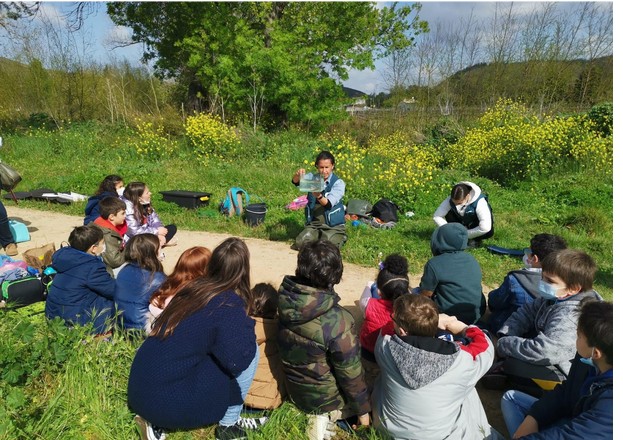Biodiversity conservation is an increasing challenge, especially for freshwater fish species.
The urgency of reversing the decline in aquatic biodiversity and promoting its conservation and recovery is widely recognised at technical and scientific levels, as well as at political and administrative levels. Among the priorities identified for this purpose are the characterisation of population trends in the face of the dynamic nature of pressures and threats, and the assessment of their risk of extinction (Red Book and National Information System for Continental Portugal’s Freshwater and Diadromous Fish).
Knowing to conserve
One of the first fundamental actions is to characterise the status of populations, taking into account the dynamic nature of threats. Only with up-to-date data is it possible to rigorously assess the risk of extinction of species and define appropriate strategies. This approach has been the basis for several conservation projects in Portugal, combining scientific research, environmental education and concrete conservation actions.
Success stories in Portugal
In recent years, Portugal has taken important steps to conserve its freshwater fish. One of the most important has been the FISHATLAS project, which for the first time carried out an exhaustive sampling of native cyprinid species in all the sub-basins where they occur. This study identified priority populations for conservation and supported the development of specific management plans (Sousa Santos et al. 2016). Also worth mentioning is the Reviving Douro project, which assessed the biodiversity of the Douro basin, with excellent results in terms of the conservation of native species, some of which are endemic to the Douro basin, and important recommendations, in particular the urgent need to create river nature reserves with permanent legal protection status and the recommendation to consider extending the Montesinho Natural Park to the south, in accordance with criteria for the conservation of riparian habitats.
At the same time, ex-situ breeding programmes have been developed to prevent the imminent extinction of critically endangered species. These programmes ensure the survival of species in captivity until their natural habitats can be restored. One of the most effective approaches is the captive rearing of endangered cyprinids with a view to their reintroduction into the wild.
Since 2007, a pioneering project has been working with six species endemic to the Iberian Peninsula: Achondrostoma occidentale (western ruivaco), Iberochondrostoma almacai (Southwestern arched mouth nase), Iberochondrostoma lusitanicum (Portuguese Boga), Squalius pyrenaicus (Southern Iberian chub), Squalius aradensis (Arade chub,) and Squalius torgalensis (Mira chub). This project is committed to semi-natural conditions for reproduction in captivity, the use of target populations as breeding stock and the limitation of the number of generations bred in captivity, ensuring the minimisation of the loss of genetic diversity and the maintenance of the behavioural repertoire of the fish to guarantee that, when released, they will easily adapt to the rivers of origin of their parents and grandparents (Sousa-Santos et al., 2014).
It is worth mentioning the case of the conservation of the western ruivaco, a species endemic to Portugal and found exclusively in the Alcabrichel, Sizandro and Safarujo river basins. This project integrated ex-situ reproduction actions, repopulation of the three river basins and identification of summer refuges, places where water is maintained even during the summer. In addition to these measures, habitat restoration actions were carried out, with visible results: a significant increase in the population was recorded, demonstrating the effectiveness of the strategy adopted (Mameri D. et al., 2016).
On the basis of these ex-situ reproduction programmes, the Ex-situ Conservation of Riverine Organisms project has also been launched for the conservation of the south-western-bogas and the Mira chub, both endemic to Portugal, in the Torgal River in Odemira, and the LIFE Saramugo project for the conservation of the Jarabugo (Anaecypris hispanica), a fish that is also highly endangered and currently restricted to a few sections of the sub-basins of the Xévora, Ardila and Vascão Rivers.
Also worth mentioning is the Native Fish Project, launched in 2017 under the coordination of researcher Carla Sousa Santos and with the support of the company Águas do Tejo Atlântico. This project promotes the annual monitoring of native cyprinid populations in intermittent rivers in central Portugal, especially during the dry season. The aim is to assess the status of the populations and support the definition of conservation measures adapted to local conditions. At the same time, the project is committed to environmental education, with awareness-raising activities in primary schools in riverine communities, involving local communities in the conservation of their aquatic ecosystems.
Among other conservation measures, and in the context of the EU Biodiversity Strategy, which sets the target of achieving at least 25,000 kilometres of barrier-free rivers in Europe by 2030, river restoration actions associated with the removal of barriers are currently worthy of note. These include the removal of the Horta do Fialho dam by the ANP/WWWF in Ribeira de Oeiras, in the Alentejo, with the main aim of recovering the southern river mussel (Unio tumidiformis) and creating the conditions for the return of other threatened fish previously present in the river, such as the needlefish (Salariopsis fluviatilis) and the sea lamprey (Petromyzon marinus). This pilot project will also make it possible to assess the level of biodiversity before and after the removal of the dam. Another noteworthy initiative is the River Restoration as a Form of Climate Action, part of the GEOTA Free Rivers Project, which proposes the restoration of the Alviela River Basin, based on a participatory strategy involving all sectors, with the special involvement of the region’s elderly population.
Commitments for the future
Despite the progress made, conservation work is far from complete. To ensure the sustainable recovery of threatened species, investment in scientific research must be increased, particularly in genetic studies to optimize ex-situ breeding programmes and ensure the preservation of genetic diversity.
Long-term monitoring of reintroduced populations is also essential to assess their adaptation to natural habitats and measure the success of conservation efforts. This ongoing assessment will allow strategies to be adapted, new threats to be identified and the most effective areas of action to be strengthened.
Other priority actions include sustainable water management by reducing excessive abstraction and promoting efficient agricultural practices. Restoring degraded habitats by reintroducing native riparian vegetation and creating ecological corridors for species migration are also key actions to increase ecosystem resilience.
Finally, integrating ecological data into reintroduction programmes can make a difference by ensuring that species are reintroduced in places where conditions are favourable for their long-term survival.



